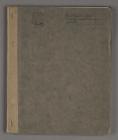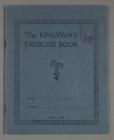Content can be downloaded for non-commercial purposes, such as for personal use or in educational resources.
For commercial purposes please contact the copyright holder directly.
Read more about the The Creative Archive Licence.
Description
Notes in English by Mrs Jocelyn Davies, replying to the National Museum's questionnaire of 1937 on Welsh folk culture, and focuses on the parish of Bedwas and includes information on the domestic life of that area.
Transcription
[MS 96_0001 ]
Replies to Questionnaire on Welsh Folk Culture (Yellow)
District- Parish of Bedwas
Section A. Domestic Life
1 Houses
(i) There are no manor Houses in this parish although there are a few in Neighbouring ones i.e. The Van, Caerphilly
(ii) Farmhouses
(a) The more substantial ones which were probably the houses of yeoman (farmers]. These were square built with rooms each side of a central door. This door was in the form of a porch with sometimes a room over it. There are three or four examples of this type but they have been extended at sometime and the extensions vary. Some are long and narrow, some have an extension which makes them L shaped.
(b) The smaller houses more often on the poorer hill farms. These are continuous with the farm bildings often with direct access to them. They mostly had one room up and down, but one example that I know of had 2. Many of these were replaced by new houses at the turn of the century. One farm is called Ty-yn-y-Cwm which I am told should be Tyddyn y cwm.
[MS 96_0002]
(c) Houses which have been extended from cottages. They originally had one room up and down.
(iii) Most of the old cottages were 2 roomed single storey thatched houses. But they were not numerous. Most of the ones in Bedwas were built in 19th cent to house colliers. They were slate roofed and in rows of three or four.
The floors of houses in parish were mostly stone flags.
(b) Most farm houses had a back kitchen containing a boiler and baking oven. This was mostly stick fired.
In one farm I know this back kitchen is still called a brewhouse and about 80 years ago it contained vats for brewing.
(c) Furniture
I cannot give much information on this subject except to say that most of the farms had clocks made by Charles Vaughan of Pontypool. Some are dated as far back as 1759. Some are brass faced others white enamel.
[MS 96_0003]
(e) I have seen pictures of Welsh Baptist ministers, one outstanding one was Christmas Evans and his one eye.
(g) In this district Caerphilly Cheese was once made and one can still see old presses. They consisted of a stout bench, in which two upright pots were slotted, in these ran a wooden box containing heavy [stock] which could be wound up with a winch. The box pressed on the vats.
Section B
2. In common with many other places there is a tradition that during the [protectorale] the parish church was desecrated and the font was [?] during 19th century being used as a horse trough in a local public house.
4. Transport
(b) Horse drawn transport consisted mainly of tip carts and gambos. Gambo was often home made with straight latch poles as shafts and main supports for floors. I have seen an old tenancy agreement of 1790 in which the tenant is allowed
[MS 96_0004]
to cut poles, for making sleds, in the wood.
The doors of many of the barns were far too low to take gambos and were obviously built for sleds.
(d) Rail transport
An old tram road called ‘Rumney (Aly)’ ran right through the parish. It was made in 1825 for horse traction. It ran from Rhymney and its iron works down to Newport. In its later years it was very congested with traffic of all sorts- horse drawn waggons, steam engines, horses being ridden and pedestrians. It was converted into the Brecon and Merthyr Railway in 1863. In the act of 1825 it stated that if locos were to be used they must consume their own smoke.
Section C
1. Two charities exist in parish
(i) Aldworth Charity
Miss Ann Aldworth left property in parish to educate children (girls) Her will was dated 1729.
Schools were held in houses for many years but a proper school was built in late 19th century. It is still used.
[MS 96_0005]
(ii) Davies Charity
Money was left by John Davies in 1860 to build a school for boys, this seems to have become a church school and is no longer used.
Section D
1. Agriculture
The parish about which I am talking is very hilly.
It consists mostly of Pennant Sandstone with pockets of Boulder Clay in places.
(a) The soil is light on the hills and heavy and (?) in the boulder clay areas.
(b) Many of the farms can be divided into three sections.
(i) The better fields usually near the homestead, mostly kept for hay and arable crops. These are all (bae’s) with some [Wauun’s] or Gwaunwydd when they are wet.
(ii) The other fields which are mostly pasture and only ploughed occasionally. Many of the hedges around these latter because (derelict) in the stamp times of 1890’s.
(iii) The rough, steep fields or [breigydd] providing grazing for sheep and cattle.
[MS 96_0006]
The proportion of arable is very small. But it is interesting to note that in 1841 when the tithes were commuted to a rentcharge 50% of the acreage of the parish was arable. During the 1939-45 war when the area under the plough was considered [?], the percentage did not reach 25% and yet in 1841 there were no [?]
The common rotation used was a modified Norfolk rotation of spring corn with lime applied; roots with dung; corn and clover and grass for 2 or more years.
In 1880 the only artificial used were dissolved bones or crushed bones.
Slag started to be used in 1890’s.
Most of the hill farms have common rights on the mountains.
One farmer represents the Lord of the Manor and he is called the “Hay Ward”
(c) The hedges are mostly quickset on a low hedgerow.
2 styles of laying are practiced.
In the older one live uprights are left.
The more modern method use out stakes.
The head of a beetle is mostly of [oak].
[MS 96_0007]
In this area there is no evidence of open fields.
Some few hedges are new and are nearly all hawthorn. The older ones are of holly, thorn and hazel.
Many of these were in existence in the 17th century.
One farm I know has fields names which are the same as they were in 1660.
(d) The ploughs used in the past on the steep fields was the iron swing plough and it is still possible to [?] with on some of the fields that have not been ploughed for some time traces of old ploughing ridges running across slope rather than down the slope.
(h) in this district the Black Glamorgan cattle were ousted by Herefords in 19th century. They gave way to Shorthorn about 1920 and they in turn have been superseded by Friesians.
The old cowhouses were very primitive with pitched floors and wide mangers with no walls. In order to feed the cattle one had to walk in the manger.
The area behind the cows was
[MS 96_0008]
Called the “[?]”. I don’t know is this a correct spelling.
All the barn machinery in 19th century was driven by horses in “horse power” as it was called.
These were made of iron some were made by Stone of Newport.
The first mowing machine came in 1872 and the old mowers used to drive bars and spikes in the ground to try and wreck it.
(iii) The sheep of each farm had a particular earmark, raddle mark and pitch mark.
There is a book containing these published by Tredegar Estate at the turn of the century.
The agricultural history of the district is largely that of Tredegar Estate as the Morgans were Lords of the manor and principal landowners for something like 800 years.
I have obtained a large number of field names from the Tithe Commutation Schedule.
Many are obviously descriptive and they are easily [?] Estates but some are very obscure.
One farm has a Cae Adam and Cae Eve.
[MS 96_0009]
4. Crafts.
There was one corn mill in the parish.
The mill leat was about ¾ mile long.
There were two malthouses in the parish.
One consisted of a three storey building. The bottom floor was half above and half below ground level.
There was a lean to building for the kiln.
The owner of the farm where this building is situated recently forund the bills for its construction in the 1790’s.
There is a place called Pandy Mawr but it has not been a fulling mill for a very long time. I can find no trace of it as such. And yet there is a Cae [?] near it.






















Do you have information to add to this item? Please leave a comment
Comments (0)
You must be logged in to leave a comment